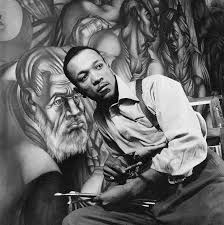The Centennial of Artist Charles White
If artist Charles White were alive he would have turned 100 on April 2. A major retrospective of his work spent the summer at the Art Institute in Chicago, where White grew up, and will reopen at the Museum of Modern Art in New York on October 7. In February it will move to Los Angeles.
I will certainly travel to Manhattan to see the show. White is a significant figure in twentieth century American art, best known as a chronicler of African American experience. He called his 1967 book “Images of Dignity” which exactly captures the essence of what he worked to communicate. White consciously sought to use art to build confidence and pride in the community he loved.
“Painting is the only weapon I have with which to fight what I resent,” he told an interviewer in 1940. “If I could write, I would write about it. If I could talk, I would talk about it. Since I paint, I must paint about it.” In 1943 and 1943 he was able to pursue that goal with the assistance of two Rosenwald fellowships.
There are so many interesting things about White and his career I hardly know where to begin. As a rebellious teenager growing up in Chicago with a busy, overburdened mother and an alcoholic step-father, White spent a lot of time in public libraries, in particular the George Cleveland Hall library where a dynamic librarian was eager to share the emerging work of the Harlem Renaissance There White discovered and was fascinated by Alain Locke’s “The New Negro,” a collection of writings by and about African Americans with illustrations by Aaron Douglas. The book was a revelation to him — despite the impression he had gotten from his largely white high school that blacks were not a significant part of American history or cultural life, here was evidence to the contrary. When a scholarship allowed him to study at the Art Institute of Chicago he not only got training in drawing but was drawn into a stimulating world of left-wing politics, artistic experimentation and interracial cooperation. Soon he was painting “Five Great American Negroes,” a mural featuring Frederick Douglass, Booker T. Washington, Sojourner Truth, Marian Anderson and George Washington Carver. Working on another mural for the 1940 American Negro Exposition he met fellow artist Elizabeth Catlett who became his first wife (and who later became, like White, a Rosenwald fellow.)
White’s career took him from Bronzeville in Chicago to Hampton, Virginia, to New York City and then to California where he moved with his second wife and enjoyed sustained success. Serving in the army during World War II White had contracted chronic lung disease which he never entirely overcame and which led to his death at the age of 61. But he lived long enough to be one of the ten black artists honored at the White House by President Jimmy Carter in April 1980. Among them were several friends from his days in Chicago and three other Rosenwald fellows — Richmond Barthe, Jacob Lawrence and Hale Woodruff.
I look forward to deepening my acquaintance with White’s work next time I’m in New York.
Charles White photographed by Rosenwald fellow Gordon Parks.
